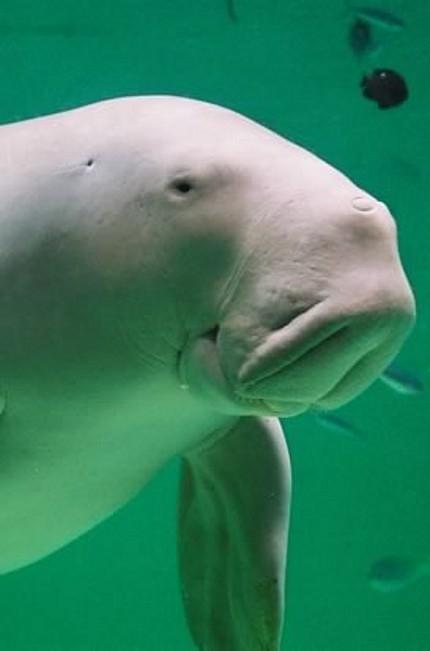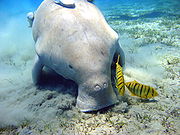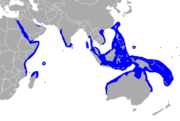Common Name: Dugong
General Description: The Dugong is also known as a sea cow.
The forelimbs are modified as flippers and vary greatly in size, and have no nails. There are no hindlimbs. The trunk is broadest in the waist region and narrows behind to form the tail fluke, which is horizontal and crescent-shaped.
The skin is thick and covered everywhere with fine hair, which give it a prickly appearance. The colouring of the dugong is variable. One individual was described as “dull brownish-grey on the back, fading to pure grey on the sides and to dirty flesh colour on the belly”. Another very small dugong was of a “very light cream colour” whilst a slightly larger one was “light brown”. Possibly, the colour changes with size or age.

Appearance At Sea: Dugongs are said not to ascend rivers nor venture far out to sea but in some parts of their range carry out long migrations in relation to water temperature. They have a peculiar surfacing where just the dorsal surface and a slow blow is sometimes visible, and a fluke that shows before a dive. Owing to this reclusive behaviour they are best studied using aerial surveys or assessing sea grass beds for grazing trails or munching sounds.
Found In: Dugongs live in shallow, sheltered coastal waters where they feed upon sea-grass.
Records from India: Three areas of the Indian coast have extant populations of the Dugong. The Gulf of Kutch, the Gulf of Mannar and Palk Bay, and the Andaman and Nicobar Islands.
World Distribution: The Dugong once had a wide distribution in the coastal tropical waters of the Indo-Pacific. It was recorded from East Africa, Mauritius and Madagascar, the Red Sea, India and Sri Lanka, Arakan and Malaysian Seas, Australia, New Guinea, Solomon Islands, Marshall Islands and New Caledonia.The range of the Dugong is still extensive but decreasing trends are observed throughout the range.
Diagnostic Features: Dugongs look unlike dolphins and whales. They do not have dorsal fins, have a different body shape, mouth shape, and colouration. Their heads are cylindrical and tube-like bent downwards for munching on sea grass.



